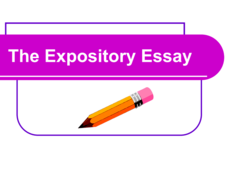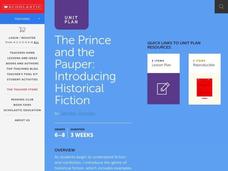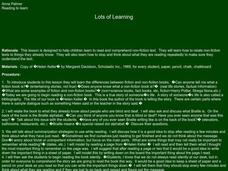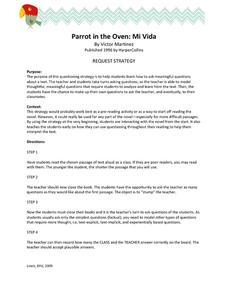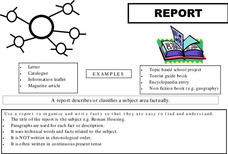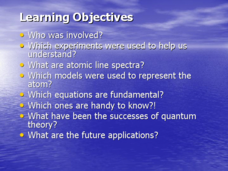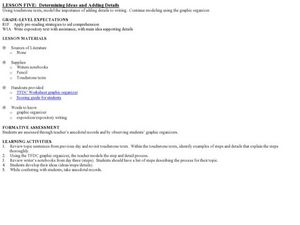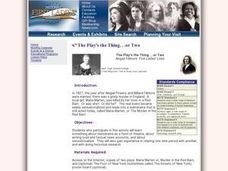Curated OER
Civil Disobedience from Antigone to Hunger Games
Study the concepts and practice of civil disobedience through fiction and nonfiction texts.
jc-schools
The Expository Essay
Did you ever create an awesome graphic organizer only to find that your class was completely baffled by how to use it? This resource not only provides you with a great graphic organizer for a standard five-paragraph essay, but also...
Curated OER
Lesson 1: Real People
A biography is a factual book or narrative about a real person. The book, The Story of Ruby Bridges is used to introduce non-fiction texts about real people and event to a Kindergarten class. A chart is used to highlight text features...
Curated OER
CLIL: A Lesson Plan
Students explore Vancouver. In this Vancouver geography and English language building lesson, students brainstorm what they know about Vancouver and predict what their text will cover. Students listen to the informational content of...
Museum of Tolerance
And Justice for All? Slavery Not Just in the Past
Slavery in India, Sudan, and Mauritania? What about in the United States? Groups research modern slavery in these four countries, collecting factual evidence (What), determine their feelings about this evidence (So what), and consider...
Curated OER
The Prince and the Pauper
Mark Twain, the famous American author, is often studied in the school system. Use "The Prince and the Pauper" to analyze the differences between the text and its video version. This lesson includes several culminating project ideas for...
Curated OER
Keep It Short!
Students examine the process of summarizing text. They participate in a class discussion, and read an assigned passage from their textbook, highlighting the main points of the text. Students then write a short summary of their...
Curated OER
Reading to Learn
Children learn to read and comprehend non-fiction text and explore how to relate non-fiction texts to things they already know. They then examine how to stop and think about what they are reading repeatedly to make sure they understand...
Curated OER
Thunder and Lightning
In this reading comprehension worksheet, students read a factual text about thunder and lightning. Students answer 8 multiple choice questions.
Curated OER
Conducting Research
Third graders conduct research. In this conducting research instructional activity, 3rd graders discuss the importance of nonfiction text in providing factual information. Students write questions about an assigned topic and research...
Curated OER
Author's Purpose Lesson Plans
Why do we practice identifying the author's purpose? Read this article to gain a better understanding of this reading strategy, and then peruse the attached lesson plans!
Curated OER
Following Instructions
Get scholars thinking about the scientific process with this fun experiment they can do at home. Learners practice reading directions as they underline each instruction in a procedural paragraph. They create a flow chart and record what...
Curated OER
Crater Creation
After looking at the back of a quarter featuring Oregon terrain, learners distinguish between fiction and non-fiction and identify the beginning, middle and end of a story. First, they listen to legends that describe the creation of...
EngageNY
Introducing Final Performance Task and Analyzing Statistics
How do statistics help people understand the universal refugee experience? Using the resource, scholars engage in an activity called a Chalk Talk, working in teams to analyze statistics from informational texts about refugees. Also, they...
Curated OER
Richard II-How Well Do You Know the Action?
Test your knowledge of the events of William Shakespeare's Richard II. Twenty-five multiple-choice questions are based on the factual information directly taken from the play.
Curated OER
Parrot in the Oven: Request Strategy
Victor Martinez's Parrot in the Oven: Mi Vida is used in an activity that models how to develop questions to aid in comprehension of a text.
Curated OER
Non Fiction Posters
A set of very useful posters (in PDF) describing different types of non-fiction texts is here for you. While there isn't an activity, per se, in these worksheets, they could be used as a handy reference for learners who are engaging in...
English Enhanced Scope and Sequence
Media Literacy with Focus of Strategies for Collaboration
Introduce your class to literary analysis with a series of activities that has them examine book and movie reviews. Groups then draft their own review of a text, select a digital medium, and craft a presentation.
Curated OER
The Who's Who of Quantum Physics
This wonderful recap of powerful figures in scientific history includes pictures, important dates, and the information about their inventions or impact. Atomic structure and the photoelectric effect are introduced. The first slide gives...
Curated OER
Determining Ideas and Adding Details
A handy TFDC (topic/fact/detail/conclusion) graphic organizer (included) allows young writers to outline and record their main ideas and supporting details in the prewriting phase. They then continue to add details to the topic sentences...
Curated OER
Comprehension Questions: The City of Ember, Chapter 20
Comprehension questions for the last chapter of Jeanne DuPrau's book The City of Ember assess factual recall, sequencing skills, and inference about the text. Note: One question about point of view is based on a sentence not related to...
Curated OER
Ancient Camel History "Cloze" Page
In this ancient camel history worksheet, students complete a cloze activity in which 7 words from a word bank are inserted into a factual text. This is to be used with an information handout that is not included here.
Curated OER
The Student Detective: A Textbook Investigation
Young scholars identify factual information using their textbook as a source of inquiry.
They become aware that a social studies text can be an object of historical investigation and develop a sense of questioning evidence as presented...
National First Ladies' Library
The Play's the Thing...or Two
Students explore melodram as a form of theatre. They write about lucid and factual news accounts and about sensationalism. Students gain experience in relating one time period with another and with doing historical research.



